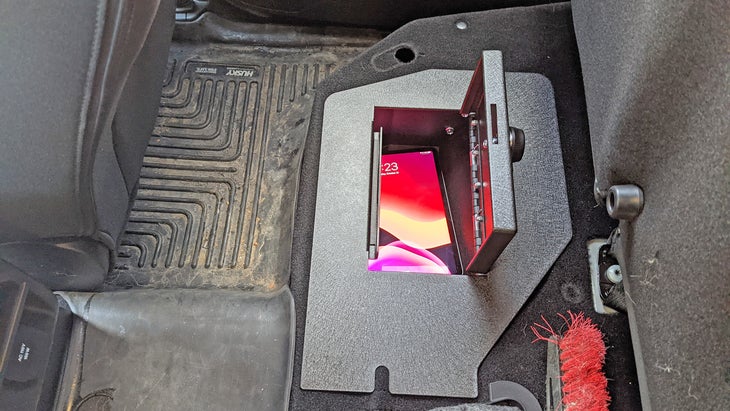Vehicle break-ins are on the rise at both trailheads and on city streets. As I wrote about in 2019, this is possibly fueled by Bluetooth technology, which allows thieves to identify the exact make and model of any gadgets you have stored in your car, and their precise location. Two years later, I think I found a solution.��
I learned a lot about vehicle security living and riding motorcycles in London, New York, and Los Angeles. Motorcycles are particularly attractive to thieves since they cost a lot of money and two strong people can easily pick them up and carry them away. Even with a garage, there’s no effective way to totally secure a motorcycle. But, despite some close calls, I managed to never get one stolen by taking a layered approach to security that involved keeping my bikes out of sight, and making them harder to steal than others in the same area.
Can you apply the same approach to stuff you may want or need to leave inside your car when it’s parked? There is no practical means to entirely prevent break-ins or to totally secure valuables. But you can hide them from sight, lock them up, and prevent them from emitting identifying signals. It’s the same layered approach I use on my motorcycles—just on a smaller scale.��
Increasingly, the kind of stuff that people want to leave in their cars when they travel is also the kind of stuff that includes Bluetooth connectivity. Phones, tablets, laptops, cameras, and similar gadgets are obvious, but things like locator dongles (Tile, Apple AirTags, etc.) add Bluetooth to valuables, like keychains, wallets, and purses, too.
How Do Thieves Use Bluetooth?
Bluetooth is a system of low power radio emitters and receivers. Devices equipped with it are constantly transmitting a signal that includes a unique digital identifier, which can be read by any one of the innumerable Bluetooth scanner smartphone apps. This can give thieves an exact shopping list of which gadgets might be hiding in your car. And, by measuring the strength of the radio signal, those apps can also direct them to the exact area in your car where those gadgets might be hiding. Those scanner apps are free, ubiquitous, and easy to use. You don’t need to have any level of technical sophistication to use them, just a Bluetooth-equipped smartphone. that thieves are leaning on them to target break-ins.
How to Prevent Thieves from Using Bluetooth to Steal Your Stuff
You can easily stop your device from emitting a signal simply by switching Bluetooth off or powering down the device. But are you going to remember to do that every time you park? Is everyone else who rides in your car and leaves something in it going to do the same? And, by leaving, say, your phone, locked up alongside any other valuable, that gadget adds risk to all your other stuff, too. Heck, aside from the cost of replacing stolen items, just dealing with a broken window is a real hassle.��
You can also store devices in something called a , which is simply an all encompassing enclosure made from any conductive material. But, even if that blocks the signal, it does nothing to physically secure the device.��
Enter in-vehicle safes, like . The company sells an easily-installed locking lid sized to individually fit the under-armrest center console storage bins on most cars and trucks. It’s more secure than you might expect, since the lid is made to be larger than the opening on the top of the console, and it screws into the frame supporting that component. But since it does not fully house its secure space in an all-encompassing, conductive enclosure, it obviously doesn’t function as a . You could combine one with a Faraday sleeve, but I wanted to find an all-in-one solution.��
Scrolling around on Console Vault’s website, I noticed that the company also makes of certain vehicles, including my new Ford Ranger. It includes an all encompassing steel bin. Would that be enough to block Bluetooth signals? I ordered one, spent five minutes installing it, then started measuring.��

I used a free scanner app I downloaded in about five seconds to identify my iPad and get a baseline signal strength reading. I also verified that the scanner could locate the iPad within half a meter. That’s more than enough location precision to pick out which car in a parking lot contains a certain device, and even figure out which window it might be hiding behind.��
Simply placing the iPad inside my car and closing the doors, I saw the signal strength fall a little bit as I stood outside. But the Ranger’s steel frame and body didn’t block enough signal to reduce location precision at all.��
Placing the iPad inside the Console Vault under my rear seat and closing the car doors instantly cut signal strength by more than half, while also reducing the scanner app’s ability to determine a precise distance to the iPad. Using the closed vehicle alone, the app was still able to pinpoint the gadgets’ location to within a half meter. The safe-vehicle combo increased that number to over six meters. That’s enough of a reduction in signal strength that it’d be hard to determine which car in a tightly packed parking lot might contain the gadget. But it’s still not enough to totally prevent the iPad from being discovered.��
Frustrated, I turned to technical descriptions of Faraday cage use in the real world and discovered that even very small gaps in material coverage can be enough to allow signals to propagate outside of the cage undiminished. And the door on the Console Vault safe’s lid does include some small gaps. I also read that simply wrapping a device in aluminum foil might work, so I tried that.��
Wrapping the iPad up in aluminum foil produced a similar result to shutting it inside the safe. Signal strength fell by more than half, and location resolution increased to over six meters. But I wanted better results, so I placed the aluminum-wrapped iPad inside the vault. That did the trick. Wrapped in a single layer of aluminum foil, the Bluetooth scanner app I’d been using dropped its connection with my iPad entirely. I tried another app to be sure, and again, no signal at all.
Is this the all-in-one, no-brainer solution I’d been looking for? I’m not going to wrap all my gadgets up in aluminum foil every time I park. But this is a good reminder that effective security involves layers, and this system achieves those. Used correctly, combining a Console Vault safe with a layer of aluminum foil or a Faraday sleeve (or double checking that devices are fully switched off, not just sleeping) will prevent thieves from knowing the location of valuables, hide that stuff from prying eyes, and prevent anyone not equipped with power tools from being able to access them. My new system’s going to add a lot of peace of mind, especially when I leave the truck unattended at trailheads for long periods of time.��


